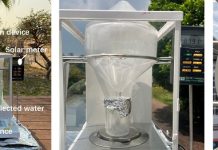
Researchers have created a new, low-cost, and energy-efficient method for capturing carbon dioxide (CO₂) directly from the air using an electrified charcoal “sponge.”
This breakthrough could help address the pressing issue of climate change.
The team from the University of Cambridge developed this method by charging activated charcoal, a material commonly used in household water filters, in a way similar to charging a battery.
By doing so, they enabled the charcoal to capture CO₂ effectively.
Activated charcoal on its own cannot hold CO₂ from the air. However, the researchers found that by charging it with ions that form reversible bonds with CO₂, it could successfully trap the gas.
This process involves charging the charcoal with hydroxide ions, which can bond with CO₂ and then release it when needed.
The electrified charcoal sponge is more energy-efficient than current carbon capture methods. It requires much lower temperatures to release the captured CO₂, making the process less costly and more sustainable.
The results of this research were published in the journal Nature.
“Capturing carbon emissions from the atmosphere is a last resort, but given the scale of the climate emergency, it’s something we need to investigate,” said Dr. Alexander Forse from the Yusuf Hamied Department of Chemistry, who led the study.
Forse emphasized that while reducing carbon emissions is the most urgent priority, removing greenhouse gases from the atmosphere is also necessary to achieve net-zero emissions and mitigate the worst effects of climate change.
Direct air capture, which uses materials to remove CO₂ from the atmosphere, is one method of carbon capture. However, current approaches are expensive, require high temperatures and natural gas, and lack stability.
“Some promising work has been done on using porous materials for carbon capture from the atmosphere,” said Forse. “We wanted to see if activated charcoal might be an option since it’s cheap, stable, and produced on a large scale.”
To test their idea, the researchers used a process similar to charging a battery. They charged an inexpensive activated charcoal cloth with hydroxide ions. During this process, the charcoal acts like an electrode in a battery, and the hydroxide ions accumulate in its tiny pores. After charging, the charcoal is removed from the “battery,” washed, and dried.
This new method of using an electrified charcoal sponge offers a promising, low-cost solution for capturing CO₂ directly from the air. It could play a crucial role in the fight against climate change, helping to reduce greenhouse gases in the atmosphere and move towards a more sustainable future.



